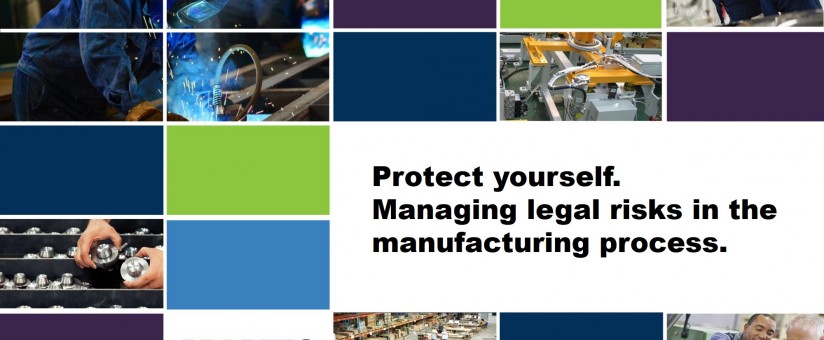MAMTC Newsletter - November, 2018. Tips for Managing Legal Risk in Manufacturing
Tips for Managing Legal Risk in Manufacturing.
There are a lot of risks associated with running any kind of business. A few are financial risks, tax considerations and regulatory compliance. However, manufacturers have an additional, unique risk, as you are creating products that go out into the world. These products can create liabilities for you beyond ordinary business concerns.
Let’s say for example that you manufacture windows. Like most business owners your concerns include pricing, labor costs, and how you will get paid. But as a manufacturer, you are creating a tangible thing that ultimately leaves your control and is used by someone else. If your product harms or injures someone, even years later, you can still face liability. Because the product that you manufacture comes with its own liabilities, there are additional considerations that manufacturers must deal with and plan for.
Manufacturers should consider taking precautions to reduce their risk of liability relating to their products at the following stages:
- During manufacturing
- During negotiating sales with your customers
- During negotiating purchasing components from suppliers
- Generally when trying to minimize risks from 3rd parties
What can you do during the manufacturing process phase to mitigate future claims for your product? Here are two steps you can take before you start the manufacturing process.
1. Make a good product.
This sounds basic but what does it include?
- Meet contract specifications
- Meet industry standards
- Meet regulatory standards
Meeting this criteria doesn’t prevent a manufacturer from being sued. But if you are sued, having met this criteria puts a manufacturer in a much better position to defend against a claim.
2. Identify actual or reasonably foreseeable potential hazards.
When creating a product, the manufacturer needs to consider potential foreseeable hazards that could be caused by the product. If there is a hazard, the rule is that the manufacturer should:
- Design away the hazard. If that cannot be done, then -
- Guard against the hazard. If that cannot be done, then -
- Warn of the hazard
Whether a manufacturer knows or should know their product creates a potential hazard can be the biggest issue in personal injury lawsuits. Plaintiffs who have been injured by products will argue that the hazard should have been reasonably foreseeable to a manufacturer, for example, that Tide should have anticipated that teenagers would eat Tide Pods. So when we are talking about taking steps at the manufacturing phase to manage the risks of product related lawsuits, be especially thorough in your consideration of the possible hazards your product might create and what you should do about those possible hazards.
For tips to consider at the other three stages which can help reduce your risk of liability relating to your products, watch the replay of MAMTC’s webinar:
Protect Yourself. Mitigating Legal Risk in the Manufacturing Process.
Contact MAMTC if you would like additional support with managing your manufacturing risks.
 Kathy Hardee is an Attorney At Law. She has over 30 years of legal experience.
Kathy Hardee is an Attorney At Law. She has over 30 years of legal experience.
Some of her areas of expertise are:
- Food industry manufacturers, producers, and distributors
- Product manufacturers who have been or could be sued for injuries relating to those products
- Businesses looking to proactively work to minimize their liability risks.
Newsletter Articles. October 2018.
Dave Stein. MAMTC's New Client Advisor
Kansas Manufacturing Influencers. KCMN
Succeeding with Lean: 4 Tips for Long-Term Improvement
Robots, Cobots and Human Labor
The Value of Ergonomics for Manufacturing. 6 Benefits of Ergonomics

